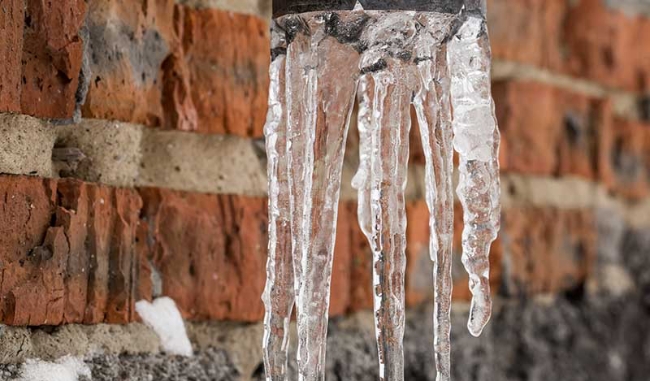Guidance for Avoiding Frozen Pipes in Winter: Specialist Insights
Guidance for Avoiding Frozen Pipes in Winter: Specialist Insights
Blog Article
What're your concepts on Helpful Tips to Prevent Frozen Pipes this Winter?

Winter can damage your plumbing, specifically by freezing pipes. Here's just how to stop it from occurring and what to do if it does.
Intro
As temperature levels drop, the threat of frozen pipelines rises, potentially resulting in costly repair services and water damages. Recognizing how to prevent frozen pipes is essential for home owners in cool environments.
Prevention Tips
Protecting vulnerable pipes
Wrap pipes in insulation sleeves or make use of heat tape to protect them from freezing temperature levels. Focus on pipes in unheated or exterior locations of the home.
Home heating strategies
Maintain indoor rooms adequately heated up, particularly locations with plumbing. Open cabinet doors to enable cozy air to circulate around pipelines under sinks.
How to recognize frozen pipes
Look for decreased water circulation from taps, uncommon odors or sounds from pipes, and noticeable frost on exposed pipes.
Long-Term Solutions
Architectural adjustments
Think about rerouting pipes away from outside walls or unheated locations. Add additional insulation to attic rooms, basements, and crawl spaces.
Updating insulation
Buy premium insulation for pipes, attic rooms, and walls. Appropriate insulation assists preserve constant temperature levels and lowers the threat of icy pipes.
Safeguarding Outside Plumbing
Garden pipes and outdoor taps
Separate and drain pipes yard tubes prior to wintertime. Set up frost-proof spigots or cover outdoor taps with shielded caps.
Comprehending Frozen Pipelines
What causes pipelines to freeze?
Pipelines freeze when subjected to temperatures listed below 32 ° F (0 ° C) for extended periods. As water inside the pipelines freezes, it broadens, taxing the pipe wall surfaces and possibly causing them to rupture.
Threats and damages
Frozen pipelines can lead to water system disturbances, residential property damage, and pricey repairs. Burst pipes can flood homes and create extensive structural damages.
Signs of Frozen Pipes
Identifying icy pipelines early can stop them from rupturing.
What to Do If Your Pipes Freeze
Immediate activities to take
If you presume frozen pipelines, keep faucets open to ease stress as the ice melts. Make use of a hairdryer or towels soaked in warm water to thaw pipelines gradually.
Verdict
Protecting against icy pipelines calls for proactive procedures and fast actions. By recognizing the reasons, indications, and preventive measures, home owners can safeguard their plumbing throughout cold weather.
6 Proven Ways to Prevent Frozen Pipes and Protect Your Home
Disconnect and Drain Garden Hoses
Before winter arrives, start by disconnecting your garden hoses and draining any remaining water. Close the shut-off valves that supply outdoor hose bibs and leave the outdoor faucet open to allow any residual water to drain. For extra protection, consider using faucet covers throughout the colder months. It’s also important to drain water from any sprinkler supply lines following the manufacturer’s directions.
Insulate Exposed Pipes
Insulating your pipes is an effective way to prevent freezing. Pipe insulation is readily available at home improvement stores and is relatively inexpensive. Pay close attention to pipes in unheated areas such as the attic, basement, crawl spaces, or garage. Apply foam insulation generously to create a buffer against the cold. You can also wrap your pipes in heat tape or thermostat-controlled heat cables for added warmth.
Seal Air Leaks
Inspect your home for any cracks or openings that could let in cold air. Seal any holes around the piping in interior or exterior walls, as well as the sill plates where your home rests on its foundation. Additionally, make sure to keep your garage door closed unless you’re entering or exiting. Leaving it open creates a significant air leak that can lead to frozen pipes.
Allow Warm Air Circulation
During cold snaps, it’s essential to allow warm air to circulate evenly throughout your home. Leave interior doors ajar to promote better airflow. Open kitchen and bathroom cabinets to help distribute heat consistently around the rooms. If you have small children or pets, be sure to remove any household chemicals or potentially harmful cleaners from open cabinets for safety.
Let Faucets Drip
A small trickle of water can make a big difference in preventing ice formation inside your pipes. When temperatures drop significantly, start a drip of water from all faucets served by exposed pipes. This continuous flow helps prevent the water from freezing. Additionally, running a few faucets slightly can relieve pressure inside the pipes, reducing the chances of a rupture if the water inside does freeze.
https://choateshvac.com/6-proven-ways-to-prevent-frozen-pipes-and-protect-your-home/

Do you really like more info about 6 Ways to Prevent Frozen Pipes? Make a remark further down. We will be happy to hear your responses about this blog. We are looking forward that you come back again later on. Enjoyed reading our write up? Please quickly share it. Let others find it. Thank-you for going through it.
Visit Our Website Report this page